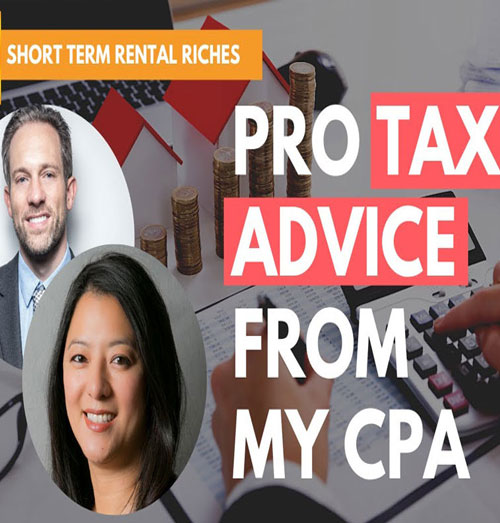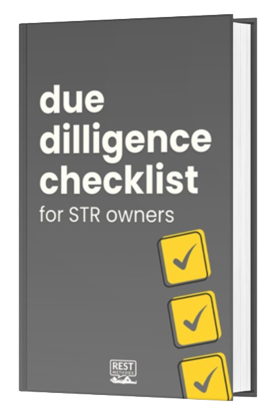211. Setting Up Your Mid-Term Rental Listing for Success (Part 1)
Welcome back to the Short Term Rental Riches Podcast! In this episode, we dive into the dynamic world of medium-term rentals. Discover invaluable insights and strategies to optimize your property for stays lasting a month or more. From choosing the right platforms to streamlining communication and setting competitive prices, this episode is your comprehensive guide to transforming your short-term rentals into lucrative medium-term opportunities.
In this episode, you’ll learn:
- Adapting Policies for Medium-Term Success
- Targeting the Right Audience
- Listing on the Right Platforms
- Alternative Guest Sources
- Instant Book and Visibility
Stay tuned for the upcoming episodes in this three-part series. Subscribe for weekly insights that will elevate your short-term rental game. If you’re navigating the evolving landscape of property rentals, this podcast is your ultimate resource.
If you found this episode helpful, don’t forget to like, share, and subscribe for more expert insights. Connect with us on our website, strriches.com, and let us know your thoughts and questions. Here’s to turning your properties into thriving medium-term rentals!
Need help managing your short-term rental and you don’t want to go it alone? Shoot us a message here and we’ll see if we can help.
Are you enjoying the podcast? Please subscribe, leave a rating and a review, and share it! This helps us reach others that may find the info helpful as well.
You can find all of our links here including our recommended resources, short-term rental playbook, Instagram, and more!
Click Here to view TranscriptWelcome to short-term rental riches. We’ll discuss investing in real estate but with a specific focus on short-term rentals. Quick, Actionable items to Acquire, Manage and Scale your portfolio. I’m your host Tim Hubbard.
Welcome back to the Short-Term Rental Riches podcast. For some of us, our short-term rentals are no longer just doing short-term reservations. Myself included, guilty as charged. A lot of my properties were now accepting guests for one month, two months, three months at a time. And this brings up a lot of different policies, a lot of different procedures, some risks, some opportunities, some pros, some cons. So, I’ve actually talked about these before. If you go back and check out episode 140, podcast episode 140, we talk about the pros and cons of medium term rentals. So, I’m actually not going to break that down in this episode. We’re going to talk about actually setting up our listings the right way to make sure we’re attracting the most medium-term guests and then how we can streamline some of these procedures and policies because they’re not integrating with our property management software.
So, the first piece of this, this is the first part of a three-part series on medium term rentals. There was just way too much to break it into one podcast and I try to keep these quick actual episodes as short as possible. I know I’ve gone a little overboard on a few and I know we’ve had some long interviews. So, if you don’t like the long episodes, please let us know. You can send an email to info at rest methods.com or you can jump on our website strriches.com. There’s a nice little handy dandy feedback form there.
So having medium term reservations starts with advertising them on the right platforms but also in the right way. So, remember before we can attract a medium term stay guest and for the purposes of this podcast, we’re going to call a medium-term guest someone who’s staying 28 days or more because remember sometimes the tax regulations are changing. Sometimes the tenant landlord laws are changing and they’re shifting from being a guest to a tenant. So, we talked about those before in episode 140. Go back and check those out if you’re curious about jumping in the medium-term rental space. So, once we’ve decided we want to do that though, we need to attract the right types of guests. And so, we need to have things in our properties like laundry. It’s very unlikely you’re going to find someone that wants to stay in your property for a month that doesn’t have their own laundry or doesn’t have access to laundry. So that’s a big one. Having a workspace of someone staying in your property for a month, they’re probably going to be working. But again, you need to know the types of guests that your property are attracting because yeah, we have lots of guests staying in nice luxury mansions now for months at a time too. Not quite as common as the smaller properties, but it is happening. So, we really need to know our guests and we need to know the amenities and things they want.
But the pretty standard ones are having a workspace, having a washer and dryer or some sort of laundry service that you could offer to the guests, being near to a grocery store or having some sort of food delivery available, having a parking spot, not in all places, but a lot of people are taking Uber now, of course, but having parking is going to attract more guests. And then of course, having really solid internet, right? And we also need to have a lot of copy in our listing that talks about long-term guests, right? The perfect place for you to stay and escape the snow season or, you know, perfect place for snowbirds coming down to joy the beach for a couple of months or whatever it happens to be.
So, first of all, we need to know our guests and we need to set our listing up to attract those types of guests that are going to want to stay longer. So, the second piece is where do we want to actually list our property? So, if you’ve been listening to the podcast for a while, you probably have a short-term rental and you’ve probably got it listed on the big ones, right? Like so Airbnb, VRBO, Booking.com, hopefully you have your own booking website. These are all the platforms that our property management software, hopefully they’re using property management software, allows us to control and manage really easily. The calendars sync together, our message systems sync together, and it’s just a lot easier to take reservations from all these different channels. But when we step into the world of medium-term rentals, we go outside of these a little bit. There’s other websites like Furnished Finder, for example. We did a whole episode on that one. If you don’t know what Furnished Finder is, go back and check out episode 203. There’s also listing sites like Apartments.com or Zillow, and these both do homes, they do all types of rental accommodations, and these are sites where people are looking as well. But unfortunately, they’re not connected into our software platforms like our traditional short-term rental listing sites like Airbnb. So, it does create some complications, but there’s some easier ways to streamline the communication. And I have those tips for you coming up here shortly.
Another excellent place where we can find longer-term guests can be with insurance companies. It can be with some sort of corporate rental placement company. It could be from universities. Be careful with university students, though. A lot of insurance companies actually ask you specifically if you’re renting to students. So, you might want to just double-check that one before you decide to do that, but that can be a really good option as well, right? A lot of times, they’re looking for a furnished rental. So, check out some of these other sources. You can also check out things like Facebook, for example. But remember, you do have the work going in to add these listings on the different websites. Let us save you the stress and headaches and some money by offering you an industry-low fee. To find out more about partnering with us, head to strriches.com, hit the property management button, answer a couple quick questions, and meet with me personally. That’s strriches.com. Rest easy knowing that with my team, your properties will be in excellent hands. Okay, so in my mind, we have these two different groups of listing sites. We have all the ones that we’ve been on traditionally that work with all of our software. And then we have the other group like apartments.com or Furnish Finder, which is really going back to traditional property management, right? We don’t have a lot of tools to streamline those. They’re not going to integrate perfectly with our dynamic software pricing or any of those things. And so that does bring up pricing. I’m going to get to that in just one quick second. But we basically have these two groups.
And so, with the first group, with the short-term rental listing sites, you have the option to accept instant books. I accept instant books on most of those sites, but I just don’t do it blindly, right? We have a lease that we’re going to want to get. We have background checks, and these are in our rental agreements, which means if we get a guest, we’re not comfortable with, or if they don’t sign our lease or complete our background check, then we can cancel those reservations penalty free. So, I’m going to save the leases and the tenant background checks, the guest background checks, the payment processing, the deposits. That’s going to be part two. Again, there’s just too much to pack in to a single episode. So that is the option. Just remember, if you turn off instant book, you’re going to turn off a lot of visibility, right? Same goes for not allowing pets. If you don’t allow pets, then you’re going to have a lot less potential guest pool. Remember, someone’s not going to want to stay in your property for two months if they can’t bring the man’s best friend, right, or they can’t bring their dog or their cat. So, remember that. Yes, that brings up more cleaning potentially, and you’ve got to have a housekeeper that’s okay with that.
We’re going to get to that in part three of this series is going to be on actually managing these guests and managing the turn and the check in and the checkout. So right now, let’s get back to these listing sites. If you turn off instant book, you’re going to turn off visibility. Now when might you want to keep instant book on? Well, let’s say you’re transitioning maybe into a medium-term rental. Maybe your traditional reservation was for three or four days. If you turn off instant book, then you’re going to turn off that possibility too. Maybe you’re open to the idea of a medium term stay if someone books it the way you have everything set up currently, right? So maybe they’re paying normal prices and they just go ahead and book a whole month. Well, that’s great, right? That’s probably a pretty good reservation. So, if you’re sort of in that limbo space where you still want to accept short term stays, but you’re also open to medium term stays, then you’re probably going to want to leave instant book on that. Granted, you want to have all the background checks and everything in place as well. The times when you want to turn instant book off completely, in my opinion, is if you’re only doing medium term stays because these are very likely going to be reservations that you’re not going to get. Someone’s usually not booking your property for several months, like within the week. It’s usually going to be a little further out, but that is one of the things that you need to know.
We’re going to talk about pricing here in a nutshell in just a second. If you’re only doing medium term stays, maybe because of the regulations, then I would turn off instant book. Someone’s going to request. And that brings up the question, how do we handle all of these requests? So, if it’s coming through Airbnb or one of your other platforms, it’s very likely going through your management software. But if it’s coming through Furnish Finder, then we’ve got to have a way to filter all those communications. So, what do I suggest? First of all, I would use as many resources you already have. So, if you have a centralized email, I highly recommend that. Or maybe your Airbnb support emails are going to the email linked to Airbnb account. Then I would try to send all of the inquiries to that same account. You can filter them out with Gmail filters if you happen to be using that. When it comes to your phone line, hopefully you have a virtual phone number set up so that even if you’re managing all your properties today, that it’s someday you can easily pass that number on to maybe a receptionist, maybe a manager, whoever it happens to be to help you with their communications. We use phone.com. It’s worked pretty well for us. So, I would forward all of your text messages and your phone calls to that same phone number. So, we want to use the same email. We want to use the same phone number and we want to use the same policies too in a nutshell. Right. So, you’re very likely going to want a longer cancellation policy if someone’s booking further out in the future and they’re reserving your calendar for a longer period of time and they cancel last minute.
Well, you’re going to be in a rush to fill that calendar, right? So, you want to look at having a stricter cancellation policy. Again, take a look at those pet policies. If you’re at all open to the idea, I promise you, you will get more bookings because the reality is there’s just less listings out there that allow pets. So, once we get an inquiry from wherever it happens to be, so if we turned off instant book on all the other platforms or we’re getting an inquiry through the platforms that don’t integrate with our software, we’re going to then need to do some background on them, right? Do they have reviews? Maybe you don’t want to accept a guest that doesn’t have reviews. So, once we get those inquiries, we really need to decide what type of guests we’re comfortable renting to. So, one of the benefits of the traditional short-term rental platforms like Airbnb is that we can see reviews. So maybe your rule is we don’t want to rent to anyone with less than two reviews. That’s something that you could easily decline if it comes in as an inquiry, right? But if we’re listing on apartments.com or listing on FurnishFinder, then unfortunately, we don’t have that. So, we are going to get in in part two to all the tenant backgrounds, the additional things that we want to ask for, but just a couple of things to sort of keep in mind when you’re considering which listing sites you want to be on.
So, the fourth piece here is on pricing. And I actually did a whole episode on pricing, so you can go back and check that out. It’s episode 186. It’s essentially the math behind what your long-term discounts should be. So, in a nutshell, a couple of things we want to consider when it comes to pricing. First of all is, is this something that’s going to be seasonal, right? Are you in the slow season and you’re trying to attract longer guests? Well, we need to know that. So hopefully you’re using a tool like PriceLabs. That’s the one we use to analyze markets, to analyze pricing, to see seasonality trends. There’s, of course, other ones like Beyond Pricing and Wheelhouse. So, check those out. If you haven’t already, great information that you need to know, especially if you want to go down with this strategy. What is your average booking window? So, are people booking two months in advance or are they traditionally booking one week in advance? And remember, this changes based on the length of reservation. So, if someone’s booking a 30-night stay versus a three-night stay, they’re very likely going to book it further out in the future. And again, that’s information that we can filter out by using things like PriceLabs. If we go and we filter minimum night stays to 30 days or more, we can see the average booking windows. So, if you’re considering the strategy, this is really important information that you need to know. One other thing you might be considering or thinking about is that different booking sites charge different commissions, right? So, Airbnb, if you’re on their old plan, you may be paying just 3% versus Booking.com. You’re paying 15%. So, we want to make sure that we have the correct channel markups in place. So, at the end of the day, we’re still earning enough money from these listing sites to make us happy, right? And you can also use this to sort of shift your preference on where someone books. Maybe you don’t like having a Booking.com guest and for people coming from Booking.com, you have a $5,000 monthly rental fee, for example. But on Airbnb, maybe it’s $4,800 after fees. So, you’re taking a little bit less, but you also have a little more comfort knowing that there is a little bit more protection there. So, you can play around with that. But whichever way you do it, whichever markups you use, I highly suggest that you have a minimum rate that you’re open to accepting. Again, we went over this in episode 186. I wish I could cram all this stuff into just one episode, but there really is a lot of minute details that go into these things. So go back, check out that episode. That’s the math behind how much and if you should be offering long-term discounts.
So, the fifth piece here to our listing setup, we talked about having the right copy and having the right photos to attract longer-term guests. We talked about being on the right listing sites. We have our traditional short-term rental listing sites. And then we also have the non-traditional ones, which we will very likely want to be on as well. There’s just a little more work that goes into them. And those are things like Apartments.com and Furnish Finder. And then we talked about a couple things to keep in mind when we want to streamline those policies and message communication. So, using a centralized email where everything goes through, using the same phone number, having the same cancellation policies, having the same rental rules and agreement lease. We’re going to get into the details on that in the next section here. So, after that, after we have our listing setup and it’s on the right listing sites, we need to make sure that we have the right price per channel. So, remember, this can change depending on the channel, depending on your preference, which ones you prefer to have it on. So, there we are. There’s a few of the things that we want to consider. I’m excited to get into part two. That’s going to go over our tenant background and screening and what we need to have in our lease. We talked a little bit about the policies and the rules. But we’re going to go more in depth in part two. So, stay tuned for that. If you are unsure, go back and check out episode 140, the pros and cons between a short- and long-term guest reservation. And then 186, how we should be calculating our pricing for that. So, I hope that helped.
If you’ve been enjoying the podcast, I would really appreciate it if you wouldn’t mind heading over to Spotify or iTunes and leaving us a review. It’ll help other people find us. You can also head to our website, strriches.com. You can request anything on there. You can search all of our past episodes. And I’d love to hear from you. I read all of our feedback and I want to thank you for tuning in. And I hope you have a fabulous week.
Whether you’re just getting started with short-term rentals or you’ve been in the game for a while, one thing remains the same. Your management can make or break your performance. Our team has learned a lot managing thousands of guests. And we put together a handbook just for you with our checklist to cover our exact process. There’s a lot to consider from verifying guests to managing reviews. And you don’t want to miss a step. You can get your free copy by going to restmethods.com. There’s no charge. It’s my gift to you for being one of our loyal subscribers. And I hope it helps you earn higher returns with less headache.















